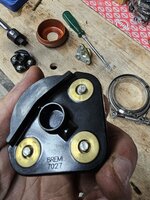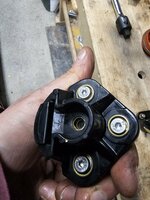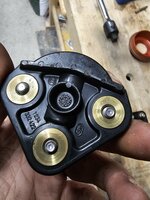Hello! I am working on a 1993 400e. I am having trouble diagnosing a crank no start issue and I was hoping someone more familiar with this platform could offer some assistance. I have searched my problem and read many threads but I seem to be chasing my tail.
I am working on this car for my friend. The car was running good for a while, started to act up and misfire on him so he took it to a shop where they replaced the caps and rotors, I confirmed this by pulling them and inspecting. It helped for a while but the problem started getting worse until it left him stranded and had to get the car towed home.
I get the car and the car wont start at all, plenty of cranking, smell of fuel, some pops here and there but no start. I get it home and check for spark, I had pulse on my timing light from one coil but not the other. Swap the "bad" coil to where the "good" coil was and don't get any spark... seemed like an easy bad ignition coil. Replaced both coils but had no change except now there was no spark on either coil! I did some forum searching and reading and it sounded like classic EZL module failure so I order one up from Ebay. It arrives, I replace the module and... still nothing. I had already checked the module was getting grounded, I checked for 12v at both large connectors, the coils and checked continuity from the - of the coils to the big round plugs on the EZL. All seemed to check out good.
At that point I started looking at the crank position sensor. I ordered a new one just to rule it out, when pulling the old one out I noticed the mounting bolt was loose! I went ahead and replaced the sensor anyways while I was in there. Went through all that still to have no spark. Pretty frustrated at this point I thought maybe the EZL from Ebay was also bad, I sent it back and ordered another more expensive 'tested' EZL. In the meantime while I was waiting I put the old EZL back in, the car actually started after a few backfires and about 30+ seconds of cranking. Sounded smooth enough so I put the timing light on but still was only getting spark to one side. Hopeful I had atleast made progress at this point I let it run for a while but after maybe 4 or 5 minutes the car died and wouldnt restart.
I just got the newest EZL today and didnt have any change with it. Started and ran after a long crank and ran on one coil for about 5 mins, died and wont restart. I actually watched the timing light as it happened, was a steady flash, started to get unsteady and then choppy then nothing. I checked fuel pressure at the rail and it has plenty, I did notice sometimes when I'm cranking seems that the fuel pump isnt turning on when cranking? But only sometimes, other times I've checked it has pressure.
Any advice on where to look next would be appreciated! A bit frustrated at this point but I've learned a lot about this engine already. One of the things on my list of things to check are the crank triggers on the flywheel.
I am working on this car for my friend. The car was running good for a while, started to act up and misfire on him so he took it to a shop where they replaced the caps and rotors, I confirmed this by pulling them and inspecting. It helped for a while but the problem started getting worse until it left him stranded and had to get the car towed home.
I get the car and the car wont start at all, plenty of cranking, smell of fuel, some pops here and there but no start. I get it home and check for spark, I had pulse on my timing light from one coil but not the other. Swap the "bad" coil to where the "good" coil was and don't get any spark... seemed like an easy bad ignition coil. Replaced both coils but had no change except now there was no spark on either coil! I did some forum searching and reading and it sounded like classic EZL module failure so I order one up from Ebay. It arrives, I replace the module and... still nothing. I had already checked the module was getting grounded, I checked for 12v at both large connectors, the coils and checked continuity from the - of the coils to the big round plugs on the EZL. All seemed to check out good.
At that point I started looking at the crank position sensor. I ordered a new one just to rule it out, when pulling the old one out I noticed the mounting bolt was loose! I went ahead and replaced the sensor anyways while I was in there. Went through all that still to have no spark. Pretty frustrated at this point I thought maybe the EZL from Ebay was also bad, I sent it back and ordered another more expensive 'tested' EZL. In the meantime while I was waiting I put the old EZL back in, the car actually started after a few backfires and about 30+ seconds of cranking. Sounded smooth enough so I put the timing light on but still was only getting spark to one side. Hopeful I had atleast made progress at this point I let it run for a while but after maybe 4 or 5 minutes the car died and wouldnt restart.
I just got the newest EZL today and didnt have any change with it. Started and ran after a long crank and ran on one coil for about 5 mins, died and wont restart. I actually watched the timing light as it happened, was a steady flash, started to get unsteady and then choppy then nothing. I checked fuel pressure at the rail and it has plenty, I did notice sometimes when I'm cranking seems that the fuel pump isnt turning on when cranking? But only sometimes, other times I've checked it has pressure.
Any advice on where to look next would be appreciated! A bit frustrated at this point but I've learned a lot about this engine already. One of the things on my list of things to check are the crank triggers on the flywheel.














